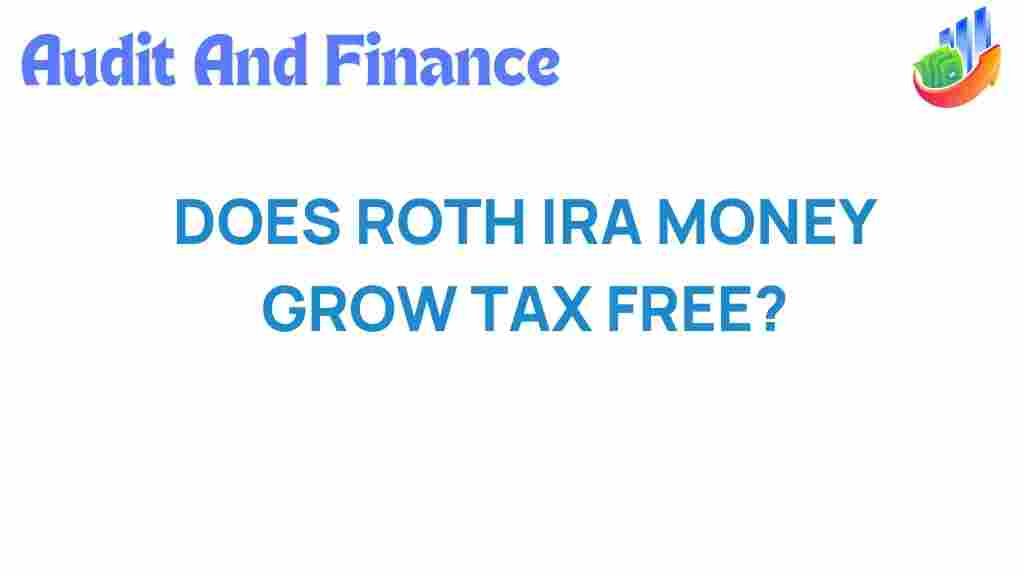Unveiling the Secrets: Does Roth IRA Money Grow Tax-Free?
When it comes to retirement savings, the Roth IRA is frequently touted as one of the most effective investment strategies. But does Roth IRA money truly grow tax-free? This article will explore the ins and outs of the Roth IRA, examining its tax benefits, how it promotes wealth accumulation, and how you can leverage it in your financial planning for a secure future.
Understanding the Roth IRA
The Roth IRA, named after Senator William Roth, was established in 1997 and has since become a popular choice for retirement savings. The primary attraction of a Roth IRA lies in its unique tax structure.
- Contributions: Unlike traditional IRAs, contributions to a Roth IRA are made with after-tax dollars. This means you pay taxes on your income before you invest it.
- Tax-Free Growth: The funds within your Roth IRA can grow tax-free. This means that any interest, dividends, or capital gains accrued in the account are not subject to taxation.
- Withdrawals: Qualified withdrawals in retirement are also tax-free, provided certain conditions are met.
How Roth IRA Money Grows Tax-Free
The concept of tax-free growth is one of the most compelling reasons to consider a Roth IRA as part of your overall retirement strategy. Here’s how it works:
- Investment Options: You can invest in a wide range of assets, including stocks, bonds, mutual funds, and ETFs, all of which can appreciate over time.
- No Required Minimum Distributions (RMDs): Unlike traditional IRAs, Roth IRAs do not impose RMDs during the account holder’s lifetime, allowing your investments to grow without interruption.
- Tax-Free Withdrawals: When you reach age 59½ and have maintained the account for at least five years, you can withdraw your earnings without incurring any taxes.
The Tax Benefits of a Roth IRA
Utilizing a Roth IRA can provide significant tax benefits that enhance your overall personal finance strategy:
- Tax Diversification: Having both pre-tax (traditional) and after-tax (Roth) accounts allows for greater flexibility in managing your tax burden in retirement.
- Lower Tax Bracket in Retirement: If you anticipate being in a higher tax bracket in retirement, a Roth IRA allows you to pay taxes now, while you are in a lower bracket.
- Legacy Planning: Roth IRAs can be passed on to heirs without immediate tax consequences, allowing for continued tax-free growth.
Investment Strategy for Roth IRA
To maximize the benefits of your Roth IRA, it’s essential to have a solid investment strategy in place. Here are some tips:
- Start Early: The earlier you start contributing to your Roth IRA, the more time your investments have to grow tax-free.
- Diversify Your Portfolio: Consider diversifying your investments across various asset classes to mitigate risk.
- Focus on Growth Investments: Since the funds in a Roth IRA can grow tax-free, consider investing in growth-oriented assets that may have higher returns over time.
- Regular Contributions: Make consistent contributions to take full advantage of dollar-cost averaging.
Step-by-Step Process to Open a Roth IRA
If you’re convinced that a Roth IRA is right for you, here’s a quick guide to opening one:
- Check Eligibility: Ensure that your income falls within the eligibility limits for contributing to a Roth IRA.
- Choose a Provider: Research and select a financial institution that offers Roth IRAs, such as banks, brokerage firms, or robo-advisors.
- Complete the Application: Fill out the application form, providing necessary identification and financial information.
- Fund Your Account: Make an initial deposit, either through a lump sum or automatic contributions.
- Choose Investments: Select the investment options that align with your goals and risk tolerance.
Troubleshooting Common Roth IRA Issues
While Roth IRAs are relatively straightforward, you may encounter some common issues. Here’s how to troubleshoot them:
- Contribution Limits: Ensure you are aware of the annual contribution limits, which may change based on IRS regulations.
- Withdrawal Rules: Familiarize yourself with the rules regarding withdrawals to avoid penalties.
- Changing Financial Situations: If your income changes, reassess your contribution strategy to maximize your tax benefits.
Conclusion: The Importance of Roth IRA in Financial Planning
In conclusion, the Roth IRA offers a unique opportunity for retirement savings with its potential for tax-free growth. By understanding the tax benefits and employing a robust investment strategy, individuals can significantly enhance their wealth accumulation and financial security for the future. Proper financial planning that includes a Roth IRA can lead to a more comfortable retirement. If you’re looking for more information, consider visiting this resource for detailed guidance on personal finance.
For additional insights on retirement planning, check out our other articles here.
This article is in the category Finance and created by AuditAndFinance Team
